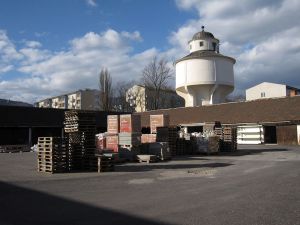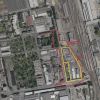
GRAZ
CATEGORY
Urban & Architectural
SITE'S FAMILY
How to Transform Physical Obstacles into New Connections?
TEAM REPRESENTATIVE
Architect
LOCATION
Graz - Österreich
POPULATION
City 280.000 inhabitants
STRATEGIC SITE
3,2 ha
SITE OF PROJECT
1,6 ha
SITE PROPOSED BY
City of Graz and ÖBB (Austrian railway company)
OWNER(S) OF THE SITE
ÖBB & Hanschmann GmbH
COMMISSION AFTER COMPETITION
Design of architectural project, possibly in partnership with other architects
Detailed information / Registration:


MAIN STATION WEST - A CENTRAL POROSITY
THE CENTRAL LOCATION IN THE WEST OF GRAZ IS A “EUROPAN KONKRET”. WITH A MIXED-USE NEIGHBOURHOOD (HOUSING, WORK, COMMERCIAL AND SOCIOCULTURAL FACILITIES) THE AIM IS TO BUILD A BRIDGE TO THE WEST AND FOR THE MAIN RAILWAY STATION TO FORMULATE ITS “WEST ENTRÉE”. IN VIEW OF THIS REVERSAL OF THE “BACK” INTO A CENTRAL DEVELOPMENT AREA, THE QUALITY OF PUBLIC, SEMI-PUBLIC AND PRIVATE OUTDOOR SPACES IS ESSENTIAL.
DER ZENTRALE GRAZER STANDORT IM WESTEN DER STADT IST EIN ´EUROPAN KONKRET´. MIT EINEM GEMISCHT GENUTZTEN STADTQUARTIER (WOHNEN, ARBEITEN, KOMMERZIELLE UND SOZIOKULTURELLE EINRICHTUNGEN) SOLL DER BRÜCKENSCHLAG IN DEN WESTEN GELINGEN UND DER HAUPTBAHNHOF SEIN „WEST-ENTRÉE“ FORMULIEREN. ANGESICHTS DIESER UMKEHRUNG DER RÜCKSEITE IN EIN ZENTRALES ENTWICKLUNGSGEBIET IST DIE QUALITÄT DER ÖFFENTLICHEN, TEILÖFFENTLICHEN UND PRIVATEN FREIRÄUME ESSENTIELL.
HOW THE SITE CAN CONTRIBUTE TO THE ADAPTABLE CITY?
The site is currently undergoing a process of major urban transformation. It is part of a redevelopment area located around the main station. Lying just next to it, on the opposite side of the tracks, the site plays a crucial role within the new station quarter: the urban configuration of the site has to connect the already redeveloped main station area on the east side to the future developments. It will be a gate to the whole area lying west of the tracks that up until now had been rather cut off from the rest of the city. The entrances of two underpasses – the main pedestrian connections of the the two sides – are located on the site. Their integration into a solid public space will be key to the development of the whole area. In relation to its surroundings the development of the site acts as a trigger: combination of a mixed-use program (housing, working, commerce, social infrastructure) and high quality public spaces initiates a transformation of the area into an urban neighbourhood.
CITY STRATEGY
The western side of Graz is currently a focus area for inner city redevelopment. In the west of Graz, the city pursues the conversion of several abandoned industrial areas into mixed use neighbourhoods – many of them located along the railway tracks. These developments are part of a broader strategy that aims for a sustainable development of the city, fostering inner city growth to counter processes of suburbanisation and the consumption of green spaces. The strategy of the city favours urban forms of living and a densification of the city structure while it seeks to raise the standards of living. Accordingly, new developments have to provide high quality of public spaces as well as access to recreational areas; they have to strengthen sustainable mobility and provide a socially balanced development.
SITE DEFINITION
The site is part of an industrial band lying between the rail tracks and Waagner-Biro-Straße which is the main access street to another large development area to the North of the site. In the South it is bordered by Eggenberger Straße, an urban axis connecting the historical center to a renaissance castle on the hills. In the course of the redevelopment of the area, both streets will be turned into pedestrian friendly public spaces. Two underpasses connect the site to the the platforms and the main station on the eastern side of the tracks. Located next to a large transportation hub as well as a tram line, the site is well connected to local public transport and the supra-regional railway system. On the site, most of the existing buildings will be removed except the water tower which is a historic landmark and buildings on the south-western corner of the site. Recent developments in the area include a university campus, a multi-purpose hall and a new park.
FUTURE OF THE SITE IN RELATION OF SITE´S FAMILY AND ADAPTABILITY
*SHARING 1: URBAN SPACES - STRONG MIX:
The site will be converted into an urban neighbourhood comprised of a mix of different uses. It will accommodate different kinds of actors: those passing through, or staying briefly; those working and those living on-site. Therefore, the development will add to the housing program commercial, cultural and social facilities that are attractive to visitors but will also provide recreational spaces to locals that can be appropriated. The urban configuration of the development has to link the site to its surroundings, like new alleys or existing industrial structures, and has to be able to adapt to its ongoing transformations.
*SHARING 2: BUILT STRUCTURES:
The built structures will house a diverse range of uses and have to adapt to their different rhythms and requirements. Simultaneously, they have to react to environmental impacts like the emission of noise coming from the streets and the tracks. The spatial structure has to combine and distribute the different programs in such a way so that they can profit from each other and form a sustainable unit. The structure should allow for diverse urban situations: working and infrastructural spaces have to be adaptable while housing spaces should invite a wide range of inhabitants.
*IMPULSE FOR THE QUARTER: The urban configuration of the Europan site will play a major role for the development of the whole area: it will be the gate to the new neighbourhood in the west and a trigger for later developments. It will be one of the first developments realized in the quarter and its urban conception sets the tone for later projects. As the main access point to/from the railway station it plays an important part in the creation of the neighbourhood´s identity.





